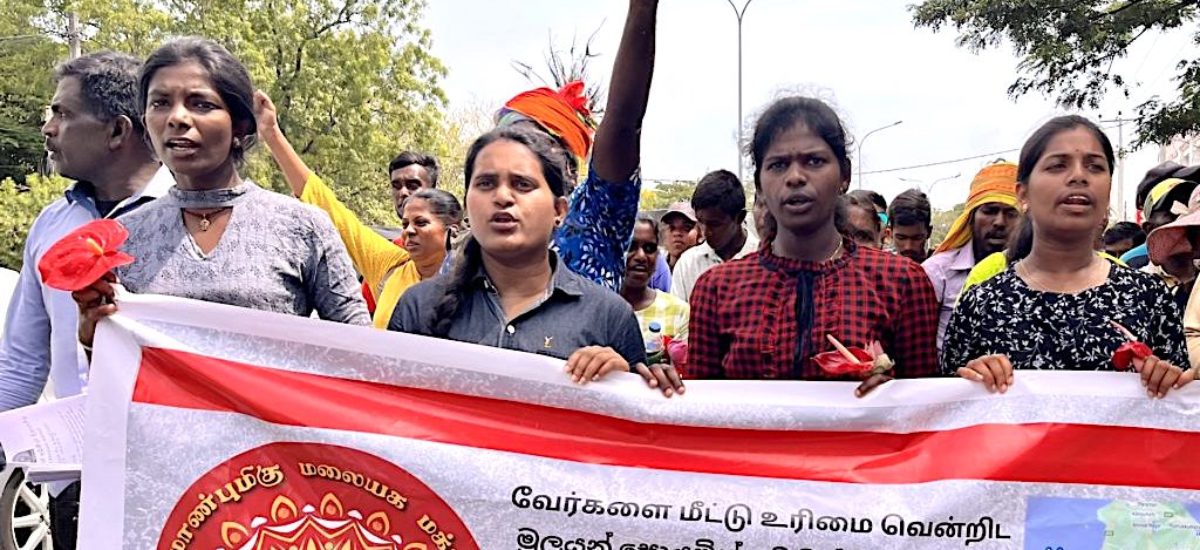Photo by Ama Koralage
People of Tamil descent raised on plantations have endured a long history of discrimination, exploitation and violence tracing back to the era of colonization. The younger generation, both men and women, expresses a preference for employment opportunities in urban areas or Middle Eastern countries as laborers rather than on plantations. Unfortunately this pursuit often results in their exploitation and entrapment in modern day slavery, a cyclical pattern that has persisted for over two centuries.
In 2023 churches, collective groups and activists, including Civil Society Organizations, united to commemorate the Malaiyaha Thamilar community. As part of this commemoration, several recommendations were put forth in collaboration with non-governmental sector partners. One recommendation advocates for the community to have the option of identifying themselves as Malaiyaha Thamilar rather than being classified as Indian Tamils to nurture a distinct identity for the community. Supporters have endorsed the request for official recognition of the community as Malaiyaha Thamilar in the ethnicity section of the upcoming census.
Many people are unaware of the existence of the Indian origin Malaiyaha Thamilar. This segment of the population has historically received little attention in both national and international human rights dialogues. Throughout history plantation Tamils have faced significant challenges, primarily stemming from structural discrimination; at one point, they even experienced statelessness. Despite cultivating a sense of belonging and considering this country their home, the classification in the census as Indian Tamils has led to feelings of exclusion.
There is a lack of attention directed towards them, which stems from their existence being primarily associated with economic rights rather than a distinct identity. The plantation community contends with systemic discrimination, evident in the structural disparities observed in schools, hospitals and limited transportation access. Structural discrimination is the new dark star in the discriminatory sky; it violates the community’s constitutional rights to nondiscrimination and damages its ability to integrate, which is often the cause of a low standard of living and marginalization.
Having resided in this country for over 200 years, why are they still categorized as Indian Tamils? Embracing their unique identity would cultivate a sense of belonging, which incorporates feeling included, respected, accepted and supported by others across various social contexts.
As each component of the definition is extracted, it correlates with the importance of Malaiyaha Thamilar community’s identity. It becomes evident that every member of the community desires to be respected, accepted and supported. Achieving this would enable them to articulate their sentiments and contribute to societal justice.
A significant number of Sri Lankan Tamils contemplated leaving the country. This desire for escape is understandable given their circumstances. However, credit must be given to the Malaiyaha Thamilar community who demonstrated a commitment to returning to Sri Lanka even during challenging times.
There is a significant under representation of the community particularly in the healthcare sector and in blue collar occupations. Conducting surveys and research through NGOs and other organizations could shed light on these disparities, illustrating how the community could be more effectively represented across various sectors.
The government’s policy of standardization, implemented in 1971 to limit the number of Tamil students admitted to certain university faculties, could be revisited. The introduction of a district quota system in 1972 aimed to address this issue but fell short in providing sufficient quotas for comprehensive inclusivity. By incorporating quotas specifically for Malaiyaha Thamilar students, future workforce sectors could ensure representation across various industries, thus promoting equitable opportunities for all segments of society.
Despite ongoing advocacy efforts, some influential members of the Indian origin community harbor reservations about the classification. An entrepreneur who has roots from India and lived on a plantation during his childhood stated, “I wanted my identity to be known as an Indian origin as it embodies the ancestral value that has been passed down through generations.”
Business vendors with roots from India express their desire to be recognized as Indian origin Tamils from Sri Lanka. They maintain connections with Indian relatives and some in Sri Lanka who possess Overseas Citizenship of India (OCI) visas, allowing them to stay. These connections foster a sense of interconnectedness and their caste affiliation serves as a strong bond for their association, distinguishing them from Indian origin Tamils who arrived in Sri Lanka as laborers under indentured agreements by the British.
The youth who have their roots through their great grandparents from India and now live in urban areas with jobs mostly in corporate sector do not know or care about their ancestry and want to be known as Sri Lankan Tamils. “Because we are born in Sri Lanka and have Sri Lankan passports, we should be known as Sri Lankan Tamils of Indian origin,” a young woman said.
The involvement of elites holds considerable sway in perpetuating discrimination against the community. Consequently, only a few like-minded groups have actively advocated for change, facing challenges in persuading the elite and political factions. However, sustained engagement from youth and women offers an opportunity to amplify their concerns and advocate for meaningful change.
The Malaiyaha Thamilar community lacks a strong sense of identity compared to the Sri Lankan Tamils who are mainly from the North, as their identity becomes an object of loyalty, devotion and pride with a rich historical heritage. They possess a collective representation with a strong Tamil diaspora, holding prominent positions in various sectors including politics, society and education. The Malaiyaha Thamilar community has historically lacked such presence and influence in these spheres, leading to lower indicators of identity assertion.
By critically reflecting on the identity of Malaiyaha Thamilar, people could gain an understanding on the complexities created by political and societal factors. To pursue this, interventions such as dialogue between small groups, panel discussions, academic research and promoting a sense of value among urban Indian origin people can foster the aims of these efforts and bring about long term solutions.

